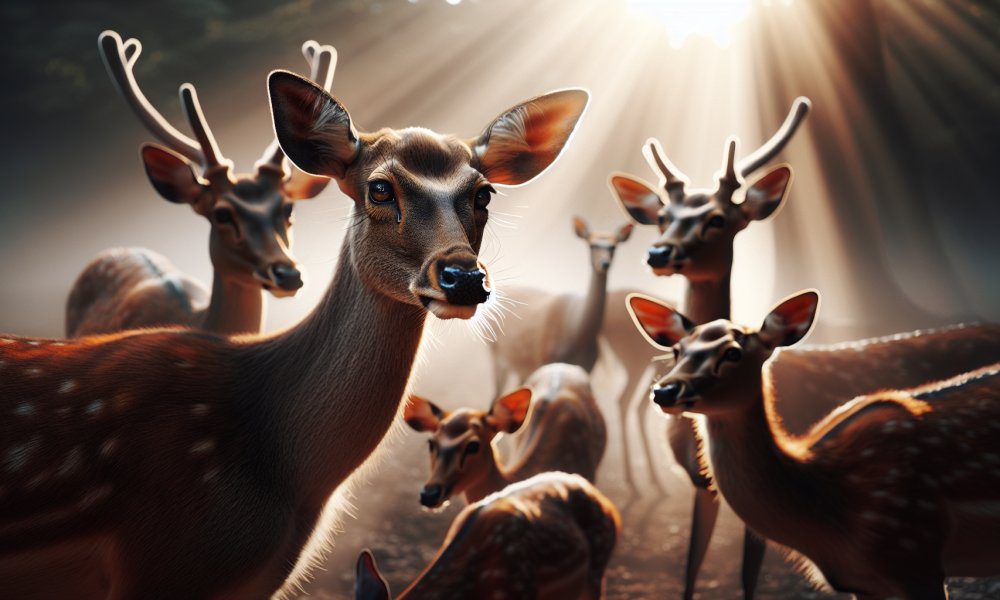✨ Free Captions Generator
আপনি যে বিষয়ে ক্যাপশন চাচ্ছেন, সেটা নিচের বক্সে লিখুন, লেখার পরে Style, Platform সিলেক্ট করে Generate বাটন এ ক্লিক করুন
ইংরেজি ভাষায় “deer” শব্দের বহুবচন নিয়ে অনেকেই প্রশ্ন তুলেন। “Deer” শব্দটি ব্যাকরণগতভাবে একটি একবচন এবং বহুবচন একই রকম হয়; অর্থাৎ, একটিকে বলা হয় “deer” এবং একাধিক হরিণের জন্যও “deer” ব্যবহার করা হয়। কিছু ক্ষেত্রে বা আঞ্চলিক উচ্চারণে “deers” ব্যবহার হতে পারে, তবে এটি স্ট্যান্ডার্ড ইংরেজিতে গ্রহণযোগ্য নয় এবং ভুল হিসেবে বিবেচিত হয়। তাই, যখন আপনি একাধিক হরিণকে উল্লেখ করতে চান, শুধুমাত্র “deer” শব্দই যথেষ্ট এবং সঠিক।
আপনি হয়তো ভাবছেন, “কেন কিছু শব্দের বহুবচন একই রকম হয়?” বা “আর কি আছে এমন মজার উদাহরণ?” এই আর্টিকেলে আমরা “deer” শব্দের বহুবচনের বিশেষত্ব এবং অন্যান্য অনুরূপ উদাহরণগুলো নিয়ে আলোচনা করব। আপনাকে দেখাব কিভাবে কিছু শব্দের বহুবচন তৈরির নিয়ম ভিন্ন হতে পারে এবং কেন “deer” এর মতো শব্দগুলি ভাষাকে আরও রঙিন করে তোলে। আপনার ভাষাজ্ঞান আরও উন্নত করতে এই আর্টিকেলটি পড়া আপনাকে নতুন নতুন তথ্য শিখতে সাহায্য করবে। তাই, চলুন নিরবচ্ছিন্নভাবে এই বিষয়টি নিয়ে গভীরভাবে জানার জন্য আর্টিকেলটি সম্পূর্ণভাবে পড়ে দেখুন এবং ভাষার জগতে এক নতুন দিগন্তে পদার্পণ করুন।
Deer Singular or Plural
The word “deer” serves as both singular and plural in English. Whether referring to one animal or multiple, the form remains unchanged. For example:
This usage simplifies communication, as the context usually clarifies whether “deer” is singular or plural.
Plural form of deer and sheep
The plural forms of both deer and sheep remain unchanged from their singular forms, illustrating an example of zero pluralization in English. This means that whether referring to one or multiple animals, the words stay the same.
Using the same form for both singular and plural helps maintain consistency in sentences. For example:
Understanding that these nouns do not change in their plural forms ensures accurate and clear communication.
Irregular plural form of deer
The word deer serves as both the singular and plural form, which is an example of an irregular plural in English. Unlike regular nouns that typically add an -s or -es to form the plural, deer remains unchanged regardless of quantity. This usage is consistent in both formal and informal contexts.
This irregularity is rooted in the word’s Old English origin, where it did not require a separate plural form. As a result, when referring to one or multiple animals of this species, the term deer is used uniformly.
Plural form of deer in a sentence
The word deer serves as both the singular and plural form. When referring to more than one deer, the word remains unchanged. Here are some examples of how to use deer in a sentence:
Using deer correctly in both singular and plural forms ensures clarity and precision in your writing.
Plural form of deer in Hindi
মিস করবেন নাঃ লাহোর প্রস্তাব কে উত্থাপন করেছেন? বিস্তারিত বিশ্লেষণ এবং প্রভাব
The plural form of deer in Hindi is हिरण (hirṇ). In some contexts, it can also be expressed as हिरणों (hirṇon). Unlike English, Hindi often uses the same word for both singular and plural forms, relying on context or additional words to indicate plurality.
The word “deer” is a fascinating example in the English language, especially when it comes to its plural forms. Unlike many English nouns that add an “s” or “es” to signify plurality, “deer” remains the same whether you’re referring to one or multiple animals. This uniformity can sometimes lead to confusion, particularly for those learning English as a second language.
Historically, the word “deer” comes from Old English “dēor,” which actually referred to any wild animal, not just the specific animal we think of today. Over time, as the language evolved, “deer” narrowed its meaning to the graceful mammals we are familiar with now. Interestingly, in its journey through the ages, the plural form remained unchanged, making it one of those unique nouns in English.
This lack of change in the plural form emphasizes the importance of context in English communication. For instance, saying “I saw three deer in the forest” clearly indicates multiple animals, while “I saw a deer” specifies just one. The sentence structure, combined with other descriptive words, helps convey the intended meaning without altering the noun itself.
Moreover, “deer” is a prime example of a zero plural noun, where the singular and plural forms are identical. This characteristic is shared with other words like “sheep,” “fish,” and “species,” each requiring the listener or reader to rely on context to understand the number being referenced. This feature adds a layer of richness and complexity to the English language, showcasing its ability to convey nuanced meanings through subtle cues.
Understanding the plural forms of words like “deer” not only enhances one’s grasp of English grammar but also enriches the appreciation of its linguistic diversity. It’s a reminder of how language evolves and adapts, preserving certain elements while transforming others to meet the communicative needs of its speakers.
Conclusion
You’ve reached the end of this article on the plural forms of deer. Thanks for reading! If you found this post helpful or interesting, please share it on your social media to spread the knowledge. We’d love to hear your thoughts, so feel free to leave a comment if you enjoyed the article or have any requests for related captions. How’s our article? Your feedback helps us create better content for you!



















